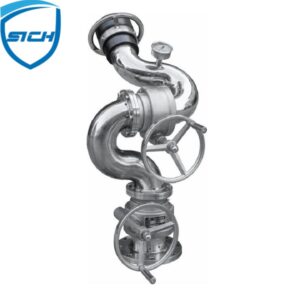The frequency of inspections and testing for fire water monitors can vary depending on local regulations, industry standards, and the specific requirements of the fire protection system. It is essential to consult relevant codes, standards, and authorities having jurisdiction to determine the specific inspection and testing intervals.
However, here are some general guidelines:
Regular Visual Inspections: Fire water monitors should undergo visual inspections on a routine basis. This includes checking for any physical damage, signs of corrosion, proper alignment, and operational readiness. Visual inspections can be conducted monthly or as per the recommended schedule provided by the manufacturer or fire protection professional.
Annual Inspections: A more comprehensive inspection should be conducted annually by qualified personnel or certified fire protection professionals. This inspection verifies the overall condition, functionality, and performance of the fire water monitor. It may involve disassembling components, inspecting internal parts, and conducting tests to ensure proper operation.
Flow Testing: Flow testing is crucial to confirm that the fire water monitor delivers the required flow rates and operates within specified parameters. Flow testing should be performed annually or as recommended by relevant standards or authorities. It involves measuring the water flow rate and pressure at various angles and patterns to ensure that the monitor meets the desired performance criteria.
Functional Testing: Functional testing verifies the operational readiness and effectiveness of the fire water monitor. This testing should be conducted periodically, typically every three to six months. It involves activating the monitor, checking the rotation, elevation, and control mechanisms, and ensuring that all features, such as adjustable patterns and flow control, are working correctly.
Maintenance and Repair: If any issues or deficiencies are identified during inspections or testing, prompt maintenance and repair should be carried out by qualified personnel. This includes addressing leaks, replacing worn or damaged parts, lubricating moving components, and ensuring proper alignment and calibration.
It is important to note that the above guidelines are general recommendations, and specific inspection and testing requirements can vary based on local regulations and industry standards. It is advisable to consult with a certified fire protection professional or relevant authorities to determine the appropriate inspection and testing intervals for fire water monitors in your specific jurisdiction or facility.
What are some common issues or deficiencies that may be identified during inspections or testing?
During inspections or testing of fire water monitors, several common issues or deficiencies may be identified. These issues can affect the performance, reliability, and functionality of the monitor. Here are some examples:
Physical Damage: Fire water monitors may be subject to physical damage due to environmental factors, accidental impact, or wear and tear. Common physical damage includes dents, cracks, bent components, or broken parts. Physical damage can affect the monitor’s structural integrity, alignment, and overall performance.
Corrosion: Corrosion can occur on the metal components of fire water monitors, especially if they are exposed to harsh environments or corrosive substances. Corrosion can weaken the structure, impair the movement of swivel joints, china fire water monitor supplier or clog water passages. Regular inspections should identify any signs of corrosion, such as rust or pitting, and appropriate measures should be taken to address it.
Leaks: Leaks can occur at various points in the fire water monitor system, including connection joints, seals, or internal components. Leaks can lead to reduced water flow, inefficient operation, or water wastage. During inspections or testing, any signs of leaks, such as dripping or pooling water, should be identified and repaired promptly.
Alignment Issues: Proper alignment is crucial for the effective operation of fire water monitors. Misalignment can result from accidental knocks, vibrations, or improper maintenance. It can affect the monitor’s ability to rotate or elevate smoothly and accurately. During inspections, misalignment should be identified and corrected to ensure the monitor’s proper functionality.
Control Mechanism Problems: Fire water monitors often have control mechanisms such as valves, handles, or remote control systems. Issues with these mechanisms can include stiffness, jamming, or failure to operate smoothly. During functional testing, the control mechanisms should be checked to ensure they are functioning properly.
Flow Rate and Pressure Deviations: Fire water monitors must deliver the required flow rate and pressure to effectively combat fires. Deviations in flow rate or pressure can indicate problems such as clogged nozzles, blockages in water passages, or issues with the water supply system. Flow testing should identify any deviations from the desired performance criteria.
Obstructions or Blockages: Obstructions or blockages can hinder the flow of water through the fire water monitor. Common obstructions include debris, sediment, or mineral deposits that accumulate over time. Inspections should identify any blockages and cleaning or flushing procedures should be performed to ensure unobstructed water flow.
Electrical or Remote Control Malfunctions: Fire water monitors equipped with electrical or remote control systems may experience malfunctions in their wiring, connections, or control panels. These issues can compromise the monitor’s remote operation capabilities or pose electrical safety hazards. Inspections should include checks of electrical components and wiring integrity.
Identifying and addressing these issues or deficiencies during inspections or testing is crucial to maintain the proper functioning and reliability of fire water monitors. Regular maintenance and prompt repairs are necessary to ensure the monitors are ready to perform their firefighting duties effectively.
